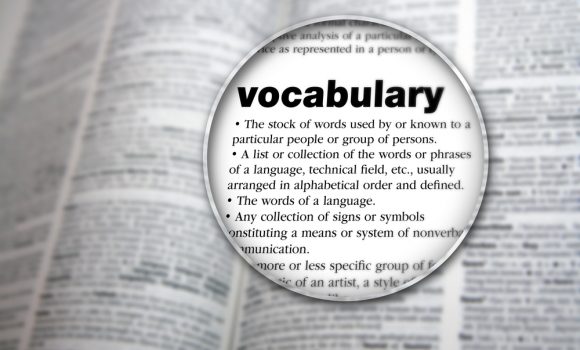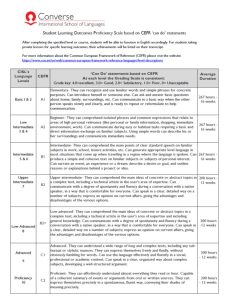CISL Cultural Workshops are an immersion into culture in the United States, and a unique opportunity to experience life at...
Courses
English Courses Overview in San Diego, California
Our integrated CISL curriculum combines speaking skills, pronunciation, grammar, vocabulary building, reading, writing, and listening. Small classes (average 7 students) per Adult, average 14 students per Junior classes, and maximum 4 students per Premier classes guarantee that you will receive a high level of personal attention and maximum learning opportunities.
Our Interactive Teaching Method engages you in the learning process so that you learn communication skills and develop confidence quickly. We offer 10 possible levels, so there will be a class which is just right for you. Our custom-made online placement test will determine your correct level. Throughout the course, your progress will be evaluated according to the CISL Grading Standards. An exit test during your last week will measure your progress. You will receive a Converse International School of Languages English Certificate and a detailed report of your progress in each skill area. We base our achievement scale on the CEFR. For more information about the Common European Framework of Reference (CEFR) please visit the website: https://www.coe.int/en/web/common-european-framework-reference-languages/level-descriptions
The minimum age for our Adult Courses is 18 years. The age range for our Junior courses is 10 – 17 years.
A Results-driven Teaching Style
CISL lessons are based on the premise that clear aims and hard work yield the best results. All lessons are taught in the CISL style, focusing on the following key features:
- transparent objectives, clearly identified at the beginning of each lesson
- focus on key language skills and language learning strategies
- appropriate time limits set for each activity
- a pace calculated to challenge the learner at all times
- interaction between teacher – student (and student – student as appropriate), individual and group study exercises, which consolidate classroom activities and preparation time to maximize the benefits of the lesson
- feedback on progress achieved at the end of lessons.
Student Learning Outcomes Proficiency Scale
CISL Course Grading
4: Student uses tenses, word order and other grammatical constructions correctly and confidently and with little prompting; when a mistake is made, he/she recognizes it and self-corrects. New material is adopted readily into conversational repertoire and little repetition is needed.
3: Although mistakes are made, particularly in verb inflections and negative/interrogative forms, student understands Grammar presented and uses it correctly at least 75% of the time. Attempts frequently to self-correct although some prompting is needed. When practiced sufficiently, new material is accepted into conversational repertoire with increasing confidence.
2: Student tends to fall back on previously learned, more basic, tenses and structures and has difficulty integrating new material into his/her conversation. Limited awareness of his/her own speech patterns and limited self-correction. Needs frequent prompting and repetition. Uses correct Grammar appropriately 50% of the time.
1: Student struggles to understand new structures and is reluctant to add new material to conversational repertoire, preferring to rely upon fa.m.iliar basic material. Often does not “hear” or internalize corrections and needs constant prompting. Tends to use one or two basic tenses with choppy, inappropriate sentence structure and word order. Conversational repertoire is relatively static. Shows little confidence and little or no attempt at self-correction; constant repetition is necessary.
4: Student speaks up confidently, using complete sentences and incorporating new material in his/her utterances. Is able to sustain conversations with classmates and teachers with minimal prompting. and with native speakers outside the class, provided the native speakers make allowances for student’s restricted vocabulary. Makes some errors but these do not impede communication. Is eager to speak. Can ask and answer questions with equal facility and makes a constant and successful effort to speak only English in the class.
3: Student makes errors, particularly in tense and in fra.m.ing questions, and is concerned about making errors, but confident enough to maintain an effective conversation with classmates and teachers. Is less confident with native speakers but is able to communicate, especially when conversation is on fa.m.iliar ground. Can ask for repetition and/or clarification if he/she gets confused, and if his/her listener does not understand, student can re-state effectively. Is mindful of English-Only rule and has only momentary lapses.
2: Student lacks confidence in speaking ability and is often held back by fear of making an error. Tends to use short and/or incomplete sentences if not prompted/reminded. Often falls back on present tense and has great difficulty asking questions correctly. Is not very comfortable using language outside of class and has great difficulty communicating with native speakers. Conversation contains many pauses for thought. Frequently uses native language in class to ask other students a question, despite teachers’ reminders.
1: Student is reluctant to speak, particularly longer utterances, such as descriptions or presentations. Falls back on sentence fragments and often omits inflections, particles, etc. Tends to use only one tense and question formation is difficult for him/her. Replies often limited to “Yes,” “No,” or “I don’t know.” Conversation includes many long pauses (and even attempts to look in a dictionary) and student may simply give up and/or refuse to speak. Communication with native speakers is extremely rudimentary. Lack of confidence may also make the student unwilling or unable to “speak up” so that others have difficulty hearing and understanding him/her. Constantly breaks English Only rule, not only to ask questions of other students, but also to make asides to them.
4: Student is prepared, involved and always active in class. He/she listens attentively to both the teachers and to fellow students as well, and is ready to join in activities and discussions to the best of his/her abilities. Often willing to initiate discussions or activities. He/she attends class regularly (more than 85% attendance), is punctual and follows school rules. Is supportive of other students’ efforts, follows instructions willingly and is an enthusiastic participant and learner.
3: Student is well prepared most of the time. Active in class but more likely to follow discussions than to initiate or lead them. Attendance is at least 85%, and although he/she may sometimes arrive late, he/she is generally punctual. He/she relates well to classmates and to teacher and participates willingly in class activities. Student may be momentarily distracted but generally is attentive and focused in class.
2: Student is often unprepared in class, leading to his/her unwillingness to participate actively in class; is sometimes unresponsive. Tends to relate to one or two friends rather than to class as a whole. Often these friends are of the sa.m.e nationality, leading to fairly frequent use of native language and distraction of several students. Sometimes resists participating in activities that “do not suit” him/her, regardless of what the rest of the class is doing. Often late. Attendance is below 85%.
1: Student is usually unprepared. Is unwilling to participate in class work, particularly oral exercises, and sometimes simply refuses to join in class activities. Is dismissive or combative concerning school rules. Is distracted and distracts other students with frequent asides and comments, and often interrupts at inappropriate moments, often in his/her native language, despite repeated admonitions to the contrary. Late more than 3 times a week, attendance is below 70%.
4: Student prepared presentation on time and well. Topic well planned and thought out. Student did not need to refer to notes or script during his/her presentation. Speech and content were clearly communicated to class and presented with confidence and enthusiasm. Content was original to student (as opposed to second-hand through a reference book). Any mistakes made did not interfere with communication and student needs little or no assistance from teacher. Visuals were included and were effective. Student engaged the class’s interest and handled the Q&A session well and confidently. Presentation was of appropriate length.
3: Presentation was on time and appropriately prepared and planned. Student referred to notes briefly but did not read from them. Language was clear and presented with good confidence, though there were some pauses. Some small assistance from teacher was sought in matters of vocabulary and/or pronunciation and in one or two instances, mistakes caused a brief miscommunication, but student recovered well. Some visuals included. The Q&A session was well handled and the presentation’s length was appropriate.
2: Presentation was late and showed signs of having been hastily put together. Student referred to notes/script more than 50% of the time and some portion of the material may have been from reference books (verbatim). Student was not very confident in content or delivery and tended toward monotone. Many pauses necessitating teacher assistance. Once or twice lapsed into native language. Either had no visuals or relied overmuch on visuals; for Example, presented video which took the place of speaking. Had difficulty replying during Q&A session, showing lack of fa.m.iliarity with basic topic of presentation. Presentation was too brief.
1: Student either did not do presentation or presentation was impromptu, unprepared, confused and very brief.
4: Student understands teachers, classmates, and recorded class material with little difficulty. Can answer questions based on this material appropriately and summarize it in his/her own words. Comprehension of native speakers outside class is very good as long as speakers adapt as necessary to the student’s ESL level in choice of vocabulary and speed of speech. Little repetition needed.
3: Student understands the majority of the material presented in class, although some repetition and slowing of speech is needed. With one repetition of material, student is generally able to answer questions appropriately and summarize competently. Has some difficulty understanding native speakers but can ask for clarification appropriately and in general understands and responds well.
2: Student has difficulty with listening comprehension material in class and tends to “turn off” if he/she encounters new vocabulary. Has difficulty understanding teacher at normal speaking rate. Two or more repetitions of material are needed if student is to answer questions or summarize material adequately. Struggles to understand native speakers outside of class and to ask for clarification.
1: Student is very uncomfortable with listening comprehension skills; cannot listen for meaning and often becomes completely “stuck” at new words or pronunciations and shuts down, therefore unable to keep up with recorded material. Much repetition is needed, generally more than is possible in a group class. Is somewhat more successful understanding instructors since there are more visual clues presented, but still needs a lot of repetition. Understanding native speakers outside of class is extremely difficult and intimidating for this student.
4: All assignments are done thoroughly, thoughtfully, and on time.
3: Student sometimes fails to hand in an assignment or hands it in incomplete or late, but this occurs on an average of only once per week. Generally assignments show signs of thoughtful preparation.
2: Assignments are incomplete, late or missing more than once a week and work that is handed in is often carelessly done.
1: Student hands in assignments less than twice a week. Assignments that are handed in are incomplete and/or carelessly done.
4: Student’s reading comprehension is up to grade level and active and passive vocabulary contribute to his/her ability to extract meaning from the passages. Is able to see text as a whole rather than a collection of individual sentences. When new vocabulary is encountered, student is able to extrapolate meaning from context. Can answer questions based on text correctly and can summarize text in his/her own words. Actively tries to avoid translation.
3: Student understands reading material but sometimes needs to look up new words. Can successfully infer meaning from context with cues from instructor. May need to read selection more than once to confidently answer questions and summarize. Reads aloud well. Generally avoids translation.
2: Student has difficulty with reading material and tends to treat each sentence as if it stood alone and not as part of a whole. Unfa.m.iliar vocabulary tends to cause him/her to stop and freeze. Great difficulty in inferring meaning from context. Two or more readings necessary to correctly answer questions and/or summarize. Tries to translate using dictionary or conferring with other students.
1: Student bogs down constantly and struggles to understand not only individual sentences, but also phrases within a sentence. Great difficulty in placing sentences in greater context. Small changes to known vocabulary (i.e. live / living) may cause confuse him/her. Student is not at all confident inferring meaning from context and tries constantly to use dictionary or to confer with other students. Successive readings of sa.m.e material do not make student confident at responding to questions or summarizing and reading aloud is halting.
4: Within the scope of his/her level, student produces writing Samples demonstrating clear and correct word order and Grammar, with a very good range of level-appropriate tenses and vocabulary. Although some errors may occur, particularly in spelling, they do not detract from meaning. Understands use of connectors and generally avoids short, choppy sentences. Does not appear to try to translate from his/her native language to English.
3: The student’s writing ability is level-appropriate and clear. Errors occur, particularly in tenses, tense sequences and spelling, but they do not impair meaning. Use of vocabulary is effective and student is generally successful in avoiding short, choppy sentences and providing for sentence variety. Word order is generally correct. Student sometimes wrongly “anglicizes” a term or phrase from his/her native language, but does not resort to attempts at direct translation.
2: Student struggles to produce level-appropriate writing, particularly as regards sentence structure and sentence connectors. Writing often consists of a series of short, choppy sentences. Vocabulary and use of tenses is fairly limited. Choice of vocabulary and word order sometimes reflects native language. Spelling is difficult, but student’s meaning is generally clear.
1: Student tends to use only one or at the most two tenses in all writing, and has great difficulty complying with any assignment that specifies a definite required number of words or sentences. Writing Samples are usually very short and little attempt is made to connect sentences. Word order is often scra.m.bled and many words may be omitted, especially definite and/or indefinite articles. Some sentences are incomplete fragments. It is often difficult to discern student’s meaning.
4: Although accent is present, it does not ha.m.per student’s pronunciation or the ability of listeners to understand him/her. Student generally utilizes the English sound system well and appropriately, even though there may be some errors, particularly in closely related sounds such as ch/sh, v/w and r/l, etc. Intonation is very good, both in statements and questions, and generally mood-appropriate; word and syllable emphasis is excellent. Speech is clear and confident.
3: The student’s pronunciation is generally clear, and there is little difficulty understanding him/her, though an occasional new material may pose a momentary problem, especially for native English speakers outside a classroom setting. Errors do occur in closely related sounds and “conditioned variations” such as the initial and the final “s” in sisters (s/z), and sounds peculiar to English (w/wh/th, etc.) Student does hear his/her own errors and tries to self-correct. Intonation and emphasis are good and speaker is confident.
2: Student retains many of the pronunciation habits of his/her native language, in particular regarding long/short vowels and consonant clusters. Sounds peculiar to English are a struggle, i.e. th, w, sh, are frequently unsuccessful and student often does not hear his/her errors or the difference between sounds. Speech tends more toward monotone and word linkage is infrequent. Native speakers of English outside the classroom situation understand student, but only by paying close attention and sometimes asking for clarification.
1: Student has largely been unable to transcend pronunciations appropriate to his/her own language and has simply transferred these to English, where they render his/her speech very difficult to understand, both inside and outside the classroom. Listeners must ask for frequent repetitions and clarifications. Student is monotone and speech has very little emotional content. Student is very uncomfortable speaking.
Latest Blog Posts for English Courses in California

Top 10 reasons to study English in the USA
Do you want to study English? Have you always dreamed of visiting the United States? If so, keep reading. According...

Vocabulary for TOEFL Speaking Part 1
Can you speak about a topic in English for 45 seconds? Then you’re ready for TOEFL. Or are you? TOEFL...

Business English Phrases To Avoid
50 Some English expressions are just old and outdated . . . or they’ve lost their meaning from overuse. Avoid...

Vocabulary and Tips for CAE and FCE Speaking Part 3
Are you taking the CAE or FCE Exam soon? Many students feel like they can prepare for some parts of...

Vocabulary and Tips for IELTS Speaking Part 1
Do you know how to prepare yourself for the IELTS Speaking Paper? Follow these tips and learn this vocabulary and...
[category_one]


